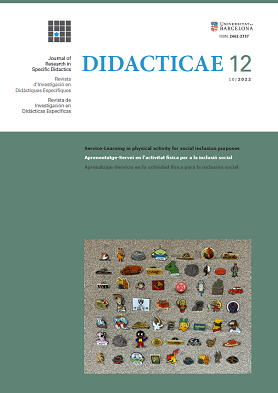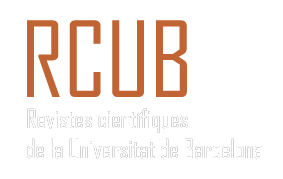Evaluación de aplicaciones de "mindfulness" con fines educativos: Desarrollo de un prototipo de "app" para adolescentes
Mindfulness in the educational context: Developing a mindfulness prototype app for teenagers
DOI:
https://doi.org/10.1344/did.2022.12.88-106Keywords:
mindfulness, Mobile App Rating Scale (MARS), ICT tools, mobile appsAbstract
Mobile applications based on mindfulness are a means that can help achieve the many psychological and physical benefits of mindfulness practices. This study aims to propose a prototype mobile mindfulness application. A systematic review of Android and iPhone mobile mindfulness applications was conducted to analyze their characteristics, quality and suitability for educational contexts using rubrics such as the Mobile App Rating Scale (MARS). A search was performed both in the Android search engine "Play Store" and in the IOS search engine "Apple Store" to analyze the applications that exist today on the market. A total of 9 applications were obtained that exceed the minimum acceptability score (3.0), only three of which exceed four on average. It is concluded that there are few applications of mindfulness for secondary education, as most are for early childhood and primary education. This opens a field for improvement in this area. Based on the results obtained, the elaboration of a mindfulness app prototype is included.
References
Anand, U. & Sharma, M.P (2014). Effectiveness of a mindfulness-based stress reduction program on stress and well-being in adolescents in a school setting. Indian Journal of Positive Psychology, 5(1), 17, s-n.
Biegel, G. & Brown, K.W. (2010). Assessing the efficacy of an adapted in class mindfulness-based training program for school-age children: A pilot study. Recuperat de https://goo.gl/3rnRd1
Britton, W.B., Lepp, N.E., Niles, H.F., Rocha, T., Fisher, N.E. & Gold, J.S. A. (2014). Randomized controlled pilot trial or classroom base mindfulness meditation compared to an active control condition in sixth-grade children. Journal of School Psychology, 52(3), 263-278. https://doi.org/10.1016/j.jsp.2014.03.002
Broderick, P.C. & Metz, S. (2009). Learning to Breathe: A pilot trial of mindfulness curriculum for adolescents. Advances in School Mental Health Promotion, 2(1), 35-46.
https://doi.org/10.1080/1754730X.2009.9715696
Burden, K., Kearney, M., & Hopkins, P. (2017). iPac App Evaluation Rubric. Recuperado de http://www.mobilelearningtoolkit.com/uploads/5/6/0/9/56096707/appevaluationinstrumentfinalrubric.pdf
Desmond, C.T., Hanich, L. & Millersville, P. A. (2010). The effects of mindful awareness teaching practices on the executive functions of students in an urban, low-income middle school. Millerville University.
Felver, J. C., & Jennings, P. A. (2016). Applications of mindfulness-based interventions in school settings: An introduction. Mindfulness, 7, 1-14.
Flook, L., Smalley, S.L., Kitil, M. J., Galla, B. M., Kaiser-Greenland, S., Locke, J., Ishijima, E. & Kasari, C. (2010). Effects of mindful awareness practices on executive funcions in elementary school children. Journal of Applied School Psychology, 26(1), 70-95. https://doi.org/10.1080/15377900903379125
Franco, C., Mañas, I., & Justo, E., (2009). Reducción de los niveles de estrés, ansiedad y depresión en docentes de educación especial a través de un programa de mindfulness. Revista de Educación Inclusiva, 2(3), 11-21.
Kabat-Zinn, J., (2003). Vivir con plenitud las crisis. Cómo utilizar la sabiduría del cuerpo y la menta para afrontar el estrés, el dolor y la enfermedad. Kairós: Barcelona.
Kuyken, W., Weare, K., Ukoumunne, C., Vicary, R., Motton, N., Burnett, R., Cullen, C., Hennelly, S. & Huppert, F. (2013). Effectiveness of the mindfulness in schools programme: non-randomised controlled feasibility study. The British Journal of Psychiatry, 203(2), 126-131. https://doi.org/10.1192/bjp.bp.113.1266
Mani, M., Kavanagh, D., Hides, L., & Stoyanov, S. (2015). Review and Evaluation of Mindfulness-Based iPhone Apps. JMIR Mhealth Uhealth, 3(3):e82.
Metz, S. M., Frank, J. L., Reibel, D., Cantrell, T., Sanders, R. & Broderick, P. C. (2013). The effectiveness of the learning to Breathe program on adolescent emotion regulation. Research in Human Development, 10(3), 252-272.
https://doi.org/10.1080/15427609.2013.818488
Monereo, C. (2009). Competencia digital: para qué, quién, dónde y cómo debe enseñarse. Aula de innovación educativa, 181, 9‐12.
Muñoz, J. M. (2008). NNTT, TIC, NTIC, TAC… en educación ¿esto qué es?, Revista de Nuevas Tecnologías y Sociedad, 51, 43-60.
Napoli, M., Krech, P.R. y Holley, L.C. (2005). Mindfulness training for elementary school students: The attention academy. Journal of Applied School Psychology, 21(1), 99-125. https://doi.org/10.1300/J370v21n01_05
Potek, R. (2012). Mindfulness as a School: Based Prevention Program and its Effect on Adolescent Stress, Anxiety and Emotion Regulation. New york University.
Prieto, S. (2015). Criterios para la utilización y diseño de aplicaciones móviles educativas. Madrid: Educaweb. Recuperado de https://www.educaweb.com/noticia/2015/04/29/criterios-utilizacion-diseno-aplicaciones-moviles-educativas-8814/
Rechtschaffen, D. (2016). Educación Mindfulness. El cultivo de la consciencia y la atención para profesores y alumnos. Madrid: Gaia ediciones.
Rosaen, C. & Benn, R. (2006). The experience of transcendental meditation in middle school students: A qualitative report. Explore: The Journal of Science and Healing, 2, 422-425. https://doi.org/10.1016/j.explore.2006.06.001
Saltzman, A. & Goldin, P. (2008). Mindfulness based stress reduction for school-age children, En S.C. Hayes y L.A. Greco (eds). Acceptance and mindfulness interventions for children adolescents and families (pp.139-161). New Harbinger.
So, K.T & Orme-Johnson, D. W. (2001). Three randomized experiments on the longitudinal effects of the Transcedental Meditation technique on cognition, Intelligence, 29(5), 419-440. https://doi.org/10.1016/S0160-2896(01)00070-8
Schonert-Reichl, E. & Lawlor, M.S. (2010). The effects of a mindfulness-based education program on pre-and early adolescents’ well-being and social and emotional competence. Mindfulness, 1(3), 137-151. https://doi.org/10.1007/s12671-010-0011-8
Schonert-Reichl, E., Oberle, E., Lawlor, M.S., Abbott, D., Thomson, K., Oberlander, T.F. & Diamond, A. (2015). Enhancing cognitive and social-emotional development through a simple-to-administer mindfulness-based school program for elementary school children: A randomized controlled trial. Psychology, 51, 52-56. https://doi.org/10.1037/a0038454
Stoyanov, S., Hides, L., Kavanagh, D., Zelenko, O., Tjondronegoro, D., & Mani, M. (2015). Mobile App Rating Scale: A New Tool for Assessing the Quality of Health Mobile Apps. JMIR Mhealth, 3(1), s-n.
Tang, Y.Y., Yang, L., Leve, L.D. i Harold, G.T. (2012). Improving executive function andits neurobiological mechanisms through a mindfulness-based intervention: Advances within the field of developmental neuroscience. Child Development Perspectives, 6, 361-366. https://doi.org/10.1111/j.1750-8606.2012.00250.x
Vallejo, A. (2016). efectos de un programa educativo basado en el uso de las tic sobre el rendimiento académico y la motivación del alumnado en la asignatura de tecnología de educación secundaria. Educación XX1, 229-250.
Vincent, T. (2011). Educational App Evaluation Rubric. Recuperado de https://learninginhand.com/blog/evaluation-rubric-for-educational-apps.html
Zambrano, J., Arango, L., & Lezcano, M. (2018). Estilos de aprendizaje, estrategias de aprendizaje y su relación con el uso de las TIC en estudiantes de Educación Secundaria. Journal of Learning Styles, 130-159.
Zoogman, S., Goldberg, S., Hoyt, W., & Miller, L. (2014). Mindfulness interventions with youth: A meta-analysis. Mindfulness, 6(2), 290-302.
Downloads
Published
Issue
Section
License
Copyright (c) 2022 Teresa Martínez Gimeno, Irene Lopez Secanell

This work is licensed under a Creative Commons Attribution-ShareAlike 4.0 International License.
The authors who publish in this journal agree to the following terms:
- Authors retain copyright and grant the journal the right of first publication.
- Submitting a paper does not involve paying any fees.
- Texts will be published under a Creative Commons Attribution Share-Alike 4.0 International License that allows others to share the work, provided they include an acknowledgement of the work’s authorship, its initial publication in this journal and the terms of the license.
- When citing works published in Didacticae, both the autor and the journal must be cited.
- Didacticae does not accept any responsibility for the points of view and statements made by the authors.



